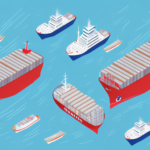Maximizing Efficiency in Supply Chain Stuffing
Managing a supply chain can be a daunting task, especially when it comes to stuffing goods into shipping containers. Efficient supply chain stuffing is essential to ensure that cargo is shipped to its destination safely and cost-effectively. In this article, we will discuss the importance of efficient supply chain stuffing, the common challenges faced in the process, best practices to improve efficiency, and ways to measure and reduce costs associated with stuffing. We will also explore the role of technology and outsourcing in streamlining supply chain stuffing operations.
The Importance of Efficient Supply Chain Stuffing
Efficient supply chain stuffing ensures that cargo is loaded and shipped as quickly as possible without compromising its safety. Proper stuffing improves transport safety, reduces transit times, and minimizes the risk of damage or theft. According to a 2023 industry report, optimized stuffing can reduce shipping costs by up to 15%. Moreover, efficient supply chain stuffing helps to optimize the use of available space in shipping containers, minimizing wasted capacity and reducing shipping costs.
Another benefit of efficient supply chain stuffing is enhanced tracking and monitoring of cargo. When cargo is properly loaded and secured, it is easier to track its location and ensure timely delivery. This is especially important for time-sensitive shipments, such as perishable goods or medical supplies. Implementing advanced tracking systems can improve visibility and accountability throughout the supply chain.
In addition, efficient supply chain stuffing positively impacts the environment. By maximizing the use of available space in shipping containers, fewer containers are needed to transport the same amount of cargo. This reduction in container usage decreases the number of trips required, thereby lowering carbon emissions and fuel consumption. It also minimizes the amount of packaging materials needed, further reducing waste and environmental impact.
Common Challenges in Supply Chain Stuffing
One of the most significant challenges in supply chain stuffing is the proper optimization of container space. Incorrect packing of goods can lead to damage, increased shipping costs, and delivery delays. Additionally, the lack of proper coordination among stakeholders in the supply chain, such as shippers, consignees, and shipping companies, can result in errors, inefficiencies, and missed deadlines.
Another challenge is managing inventory levels effectively. Overstocking or understocking can lead to increased storage costs, stockouts, and lost sales. The Global Supply Chain Survey 2023 indicates that 60% of companies face difficulties in maintaining accurate inventory levels. The lack of visibility into inventory levels and demand forecasts can complicate supply chain planning and execution. Therefore, having accurate and timely information about inventory is crucial for optimizing supply chain stuffing.
Streamlining Your Supply Chain Stuffing Process
Streamlining the supply chain stuffing process can minimize the time and resources required to load or unload cargo and reduce manual labor costs. Adopting digital tools, including cloud-based software, barcoding, and RFID technology, is one of the most effective measures. These tools enable shippers and consignees to efficiently track shipping movements and identify containers that require stuffing or unstuffing.
Another strategy is optimizing the layout of the cargo using specialized software that calculates the most efficient loading patterns. This maximizes the use of available space and reduces the number of containers needed for transportation. Additionally, using standardized packaging and pallets can help optimize layout and reduce the time required for stuffing and unstuffing.
The Role of Technology in Supply Chain Stuffing Efficiency
Technology plays a crucial role in enhancing supply chain stuffing efficiency. Digital tools facilitate coordination and collaboration among stakeholders, including shippers, consignees, and freight forwarders. By automating processes and sharing critical data, these tools can reduce the time and resources required for stuffing, while increasing the safety and efficiency of shipping.
Furthermore, technology provides real-time tracking and monitoring of shipments, offering greater visibility and control over the entire supply chain. This allows for the early identification of potential issues or delays, enabling proactive measures to mitigate negative impacts. Predictive analytics, enabled by technology, helps optimize supply chain stuffing by identifying patterns and trends in data, leading to more informed decision-making. Overall, technology is essential for improving efficiency, reducing costs, and enhancing the overall customer experience in supply chain stuffing.
Best Practices for Maximizing Efficiency in Supply Chain Stuffing
Adopting best practices can significantly improve the efficiency of supply chain stuffing operations. These include:
- Proper Labeling and Categorization: Ensure goods are properly labeled and categorized to allow for efficient sorting and packing.
- Optimized Pallet Use: Maximize container space and minimize loading time by optimizing pallet configurations.
- Secure Packaging: Use appropriate wrapping or securing mechanisms to minimize damage and reduce transport risks.
- Quality Control: Implement strict quality control processes to ensure all goods meet safety standards before shipment.
Another crucial best practice is maintaining clear communication and coordination among all parties involved in the stuffing process, including suppliers, manufacturers, distributors, and logistics providers. Clear communication helps minimize delays and errors, streamlining the entire process for maximum efficiency.
Key Metrics to Measure Efficiency in Supply Chain Stuffing
Measuring efficiency in supply chain stuffing is essential to identify bottlenecks and inefficiencies. Key metrics include:
- Lead Time: The time taken to stuff goods into shipping containers.
- Container Space Utilization: The percentage of container space used effectively.
- Damage or Loss Rates: The number of damaged or lost goods during shipping.
- Cost of Labor and Materials: The expenses associated with stuffing and unstuffing operations.
Additionally, the accuracy of inventory management is a critical metric. Tracking the number of items stuffed into each container and ensuring the correct items are included helps prevent delays and additional costs. Environmental impact metrics, such as waste generated and carbon emissions, are also important for improving sustainability and company reputation.
Ways to Reduce Costs and Improve Efficiency in Supply Chain Stuffing
Several strategies can help reduce costs and enhance efficiency in supply chain stuffing:
- Optimize Container Space: Minimize wasted capacity to reduce shipping costs.
- Use Specialized Packaging: Optimize pallet configurations to reduce loading and unloading time.
- Implement Quality Control: Prevent errors and minimize losses through strict quality control systems.
- Adopt Digital Tools: Facilitate coordination and collaboration among stakeholders to optimize stuffing operations.
Implementing a Just-In-Time (JIT) inventory system can also reduce costs and improve efficiency by ensuring materials and products are delivered only when needed, minimizing storage space and the risk of overstocking or stockouts.
Additionally, companies can consider outsourcing their stuffing operations to third-party logistics providers (3PLs). These providers offer specialized expertise and resources to optimize stuffing operations and reduce costs, allowing companies to focus on their core competencies and enhance overall supply chain performance.
The Benefits of Outsourcing Your Supply Chain Stuffing Operations
Outsourcing supply chain stuffing operations allows businesses to focus on their core operations while efficiently managing shipping and logistics needs. Benefits of outsourcing include reduced operating costs, elimination of the need for additional staffing and resources, and minimized risk exposure. Outsourcing also ensures greater consistency and quality control in supply chain stuffing operations.
Another advantage is access to specialized expertise and technology. Outsourcing companies often possess the latest technology and equipment, along with experienced staff trained in industry best practices. This expertise can enhance supply chain efficiency and reduce the risk of errors or delays.
Furthermore, outsourcing provides scalability. As businesses grow, their shipping and logistics capacity needs increase. Outsourcing allows for quick and easy expansion without significant investments in additional resources or infrastructure, helping companies stay competitive and meet evolving customer demands.
Case Studies: Companies that Successfully Maximized Efficiency in Supply Chain Stuffing
Several companies have successfully optimized their supply chain stuffing operations through digital tools, best practices, and outsourcing. For instance, container giant CMA CGM invested in an automated container terminal management system that reduced crane waiting times and optimized container stuffing operations. Similarly, Qingdao Port in China, one of the world's largest ports, equipped multiple cranes with RFID readers and sensors to optimize terminal operations, detect bottlenecks, and reduce waiting times.
Closing Thoughts
In conclusion, efficient supply chain stuffing is critical to ensure goods are shipped safely, cost-effectively, and on time. By adopting best practices, outsourcing, and utilizing digital tools, companies can maximize the efficiency and minimize the costs of their supply chain stuffing operations. Measuring stuffing metrics helps identify areas for improvement, while maintaining strict quality control ensures high standards are met.
Another example of successful optimization is Amazon. The e-commerce giant implemented a system using algorithms to determine the optimal size and weight of boxes for each order, reducing empty space in packages and minimizing the number of boxes needed for shipping. This approach not only saves on shipping costs but also reduces the environmental impact of packaging materials. By continuously analyzing and improving their supply chain stuffing operations, Amazon maintains its position as a leader in the e-commerce industry.




















